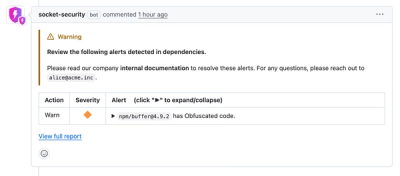
Security News
Crates.io Users Targeted by Phishing Emails
The Rust Security Response WG is warning of phishing emails from rustfoundation.dev targeting crates.io users.
An Artificial Intelligence Automation Platform. AI Instruction management from various providers, has an adaptive memory, and a versatile plugin system with many commands including web browsing. Supports many AI providers and models and growing support every day.
AGiXT is a dynamic Artificial Intelligence Automation Platform engineered to orchestrate efficient AI instruction management and task execution across a multitude of providers. Our solution infuses adaptive memory handling with a broad spectrum of commands to enhance AI's understanding and responsiveness, leading to improved task completion. The platform's smart features, like Smart Instruct and Smart Chat, seamlessly integrate web search, planning strategies, and conversation continuity, transforming the interaction between users and AI. By leveraging a powerful plugin system that includes web browsing and command execution, AGiXT stands as a versatile bridge between AI models and users. With an expanding roster of AI providers, code evaluation capabilities, comprehensive chain management, and platform interoperability, AGiXT is consistently evolving to drive a multitude of applications, affirming its place at the forefront of AI technology.
Embracing the spirit of extremity in every facet of life, we introduce AGiXT. This advanced AI Automation Platform is our bold step towards the realization of Artificial General Intelligence (AGI). Seamlessly orchestrating instruction management and executing complex tasks across diverse AI providers, AGiXT combines adaptive memory, smart features, and a versatile plugin system to maximize AI potential. With our unwavering commitment to innovation, we're dedicated to pushing the boundaries of AI and bringing AGI closer to reality.
Please note that using some AI providers (such as OpenAI's GPT-4 API) can be expensive! Monitor your usage carefully to avoid incurring unexpected costs. We're NOT responsible for your usage under any circumstances.
The features that AGiXT provides cover a wide range of services and are used for different tasks. Refer to Processes and Frameworks for more details about the services and framework.
Provide the following prerequisites based on the Operating System you use.
If you're using Linux, you may need to prefix the python command with sudo depending on your system configuration.
git clone https://github.com/Josh-XT/AGiXT
cd AGiXT
python start.py
The script will check for Docker and Docker Compose installation:
Run the script with Python:
python start.py
To run AGiXT with ezLocalai, use the --with-ezlocalai flag:
python start.py --with-ezlocalai true
You can also use command-line arguments to set specific environment variables to run in different ways. For example, to use the development branch and enable auto-updates, run:
python start.py --agixt-branch dev --agixt-auto-update true --with-ezlocalai true
The script supports setting any of the environment variables via command-line arguments. Here's a detailed list of available options:
--agixt-api-key: Set the AGiXT API key (automatically generated if not provided)--agixt-uri: Set the AGiXT URI (default: http://localhost:7437)--agixt-agent: Set the default AGiXT agent (default: AGiXT)--agixt-branch: Choose between stable and dev branches--agixt-file-upload-enabled: Enable or disable file uploads (default: true)--agixt-voice-input-enabled: Enable or disable voice input (default: true)--agixt-footer-message: Set the footer message (default: Powered by AGiXT)--agixt-require-api-key: Require API key for access (default: false)--agixt-rlhf: Enable or disable reinforcement learning from human feedback (default: true)--agixt-show-selection: Set which selectors to show in the UI (default: conversation,agent)--agixt-show-agent-bar: Show or hide the agent bar in the UI (default: true)--agixt-show-app-bar: Show or hide the app bar in the UI (default: true)--agixt-conversation-mode: Set the conversation mode (default: select)--allowed-domains: Set allowed domains for API access (default: *)--app-description: Set the application description--app-name: Set the application name (default: AGiXT Chat)--app-uri: Set the application URI (default: http://localhost:3437)--auth-web: Set the authentication web URI (default: http://localhost:3437/user)--auth-provider: Set the authentication provider (options: none, magicalauth)--create-agent-on-register: Create an agent named from your AGIXT_AGENT environment variable if it is different than AGiXT using settings from default_agent.json if defined (default: true)--create-agixt-agent: Create an agent called AGiXT and trains it on the AGiXT documentation upon user registration (default: true)--disabled-providers: Set disabled providers (comma-separated list)--disabled-extensions: Set disabled extensions (comma-separated list)--working-directory: Set the working directory (default: ./WORKSPACE)--github-client-id: Set GitHub client ID for authentication--github-client-secret: Set GitHub client secret for authentication--google-client-id: Set Google client ID for authentication--google-client-secret: Set Google client secret for authentication--microsoft-client-id: Set Microsoft client ID for authentication--microsoft-client-secret: Set Microsoft client secret for authentication--tz: Set the timezone (default: system timezone)--interactive-mode: Set the interactive mode (default: chat)--theme-name: Set the UI theme (options: default, christmas, conspiracy, doom, easter, halloween, valentines)--allow-email-sign-in: Allow email sign-in (default: true)--database-type: Set the database type (options: sqlite, postgres)--database-name: Set the database name (default: models/agixt)--log-level: Set the logging level (default: INFO)--log-format: Set the log format (default: %(asctime)s | %(levelname)s | %(message)s)--uvicorn-workers: Set the number of Uvicorn workers (default: 10)--agixt-auto-update: Enable or disable auto-updates (default: true)Options specific to ezLocalai:
--with-ezlocalai: Start AGiXT with ezLocalai integration.--ezlocalai-uri: Set the ezLocalai URI (default: http://{local_ip}:8091)--default-model: Set the default language model for ezLocalai (default: QuantFactory/dolphin-2.9.2-qwen2-7b-GGUF)--vision-model: Set the vision model for ezLocalai (default: deepseek-ai/deepseek-vl-1.3b-chat)--llm-max-tokens: Set the maximum number of tokens for language models (default: 32768)--whisper-model: Set the Whisper model for speech recognition (default: base.en)--gpu-layers: Set the number of GPU layers to use (automatically determined based on available VRAM but can be modified.) (default: -1 for all)For a full list of options with their current values, run:
python start.py --help
After setting up the environment variables and ensuring Docker and Docker Compose are installed, the script will:
sudo.python command is not recognized, try using python3 instead.AGIXT_API_KEY is automatically generated if not provided. Ensure to keep this key secure and do not share it publicly.Each AGiXT Agent has its own settings for interfacing with AI providers, and other configuration options. These settings can be set and modified through the web interface.
Videos
https://github.com/user-attachments/assets/5dceb1b2-dfbc-4c2d-b648-974882eff08d
https://github.com/user-attachments/assets/2111009a-17e0-42e5-bcbc-843d127495e0
Need more information? Check out the documentation for more details to get a better understanding of the concepts and features of AGiXT.
Check out the other AGiXT repositories at https://github.com/orgs/AGiXT/repositories - these include the AGiXT Streamlit Web UI, AGiXT Python SDK, AGiXT TypeScript SDK, AGiXT Dart SDK, AGiXT C# SDK, and more!
graph TD
Start[Start] --> IA[Initialize Agent]
IA --> IM[Initialize Memories]
IM --> A[User Input]
A --> B[Multi-modal Input Handler]
B --> B1{Input Type?}
B1 -->|Text| C[Process Text Input]
B1 -->|Voice| STT[Speech-to-Text Conversion]
B1 -->|Image| VIS[Vision Processing]
B1 -->|File Upload| F[Handle file uploads]
STT --> C
VIS --> C
F --> C
C --> S[Log user input]
C --> T[Log agent activities]
C --> E[Override Agent settings if applicable]
E --> G[Handle URLs and Websearch if applicable]
G --> H[Data Analysis if applicable]
H --> K{Agent Mode?}
K -->|Command| EC[Execute Command]
K -->|Chain| EX[Execute Chain]
K -->|Prompt| RI[Run Inference]
EC --> O[Prepare response]
EX --> O
RI --> O
O --> Q[Format response]
Q --> R[Text Response]
R --> P[Calculate tokens]
P --> U[Log final response]
Q --> TTS[Text-to-Speech Conversion]
TTS --> VAudio[Voice Audio Response]
Q --> IMG_GEN[Image Generation]
IMG_GEN --> GImg[Generated Image]
subgraph HF[Handle File Uploads]
F1[Download files to workspace]
F2[Learn from files]
F3[Update Memories]
F1 --> F2 --> F3
end
subgraph HU[Handle URLs in User Input]
G1[Learn from websites]
G2[Handle GitHub Repositories if applicable]
G3[Update Memories]
G1 --> G2 --> G3
end
subgraph AC[Data Analysis]
H1[Identify CSV content in agent workspace or user input]
H2[Determine files or content to analyze]
H3[Generate and verify Python code for analysis]
H4[Execute Python code]
H5{Execution successful?}
H6[Update memories with results from data analysis]
H7[Attempt code fix]
H1 --> H2 --> H3 --> H4 --> H5
H5 -->|Yes| H6
H5 -->|No| H7
H7 --> H4
end
subgraph IA[Agent Initialization]
I1[Load agent config]
I2[Initialize providers]
I3[Load available commands]
I4[Initialize Conversation]
I5[Initialize agent workspace]
I1 --> I2 --> I3 --> I4 --> I5
end
subgraph IM[Initialize Memories]
J1[Initialize vector database]
J2[Initialize embedding provider]
J3[Initialize relevant memory collections]
J1 --> J2 --> J3
end
subgraph EC[Execute Command]
L1[Inject user settings]
L2[Inject agent extensions settings]
L3[Run command]
L1 --> L2 --> L3
end
subgraph EX[Execute Chain]
M1[Load chain data]
M2[Inject user settings]
M3[Inject agent extension settings]
M4[Execute chain steps]
M5[Handle dependencies]
M6[Update chain responses]
M1 --> M2 --> M3 --> M4 --> M5 --> M6
end
subgraph RI[Run Inference]
N1[Get prompt template]
N2[Format prompt]
N3[Inject relevant memories]
N4[Inject conversation history]
N5[Inject recent activities]
N6[Call inference method to LLM provider]
N1 --> N2 --> N3 --> N4 --> N5 --> N6
end
subgraph WS[Websearch]
W1[Initiate web search]
W2[Perform search query]
W3[Scrape websites]
W4[Recursive browsing]
W5[Summarize content]
W6[Update agent memories]
W1 --> W2 --> W3 --> W4 --> W5 --> W6
end
subgraph PR[Providers]
P1[LLM Provider]
P2[TTS Provider]
P3[STT Provider]
P4[Vision Provider]
P5[Image Generation Provider]
P6[Embedding Provider]
end
subgraph CL[Conversation Logging]
S[Log user input]
T[Log agent activities]
end
F --> HF
G --> HU
G --> WS
H --> AC
TTS --> P2
STT --> P3
VIS --> P4
IMG_GEN --> P5
J2 --> P6
N6 --> P1
F --> T
G --> T
H --> T
L3 --> T
M4 --> T
N6 --> T
style U fill:#0000FF,stroke:#333,stroke-width:4px
FAQs
An Artificial Intelligence Automation Platform. AI Instruction management from various providers, has an adaptive memory, and a versatile plugin system with many commands including web browsing. Supports many AI providers and models and growing support every day.
We found that agixt demonstrated a healthy version release cadence and project activity because the last version was released less than a year ago. It has 1 open source maintainer collaborating on the project.
Did you know?

Socket for GitHub automatically highlights issues in each pull request and monitors the health of all your open source dependencies. Discover the contents of your packages and block harmful activity before you install or update your dependencies.

Security News
The Rust Security Response WG is warning of phishing emails from rustfoundation.dev targeting crates.io users.

Product
Socket now lets you customize pull request alert headers, helping security teams share clear guidance right in PRs to speed reviews and reduce back-and-forth.

Product
Socket's Rust support is moving to Beta: all users can scan Cargo projects and generate SBOMs, including Cargo.toml-only crates, with Rust-aware supply chain checks.